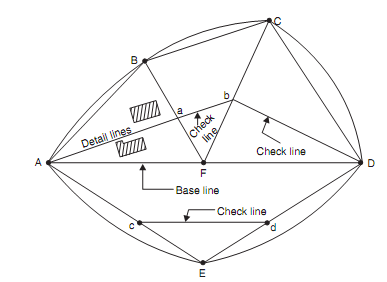CHAIN SURVEYING
Chain survey is appropriate in the following cases:
- Area to be surveyed is fairly small
- Ground is fairly level
- Area is open and
- Details to be filled up are less and simple.
In chain only surveying linear measurements are made for example: no angular measurements are made. As triangle is the only figure that can be plotted with measurement of sides only, in chain surveying with a network of triangles the area to be surveyed should be covered. Given figure shows a typical scheme of covering an area with a network of triangles. To precisely get plotted position of a station, no angle of the network triangles should be less than 30º with respect to already plotted positions of other station. As far as possible angle should be close to 60º. On the other hand, the arrangements of triangles to be adopted depend on the, topography, shape, natural and artificial obstacles in the field.

Network of triangles
In connection various technical terms used with the network of the triangles in surveying are described below:
Station: Station is a point of importance at the starting or at the end of a survey line.
Main station: These are the stations at the starting or at the end of lines forming major skeleton. They are mention as A, B, C etc.
Subsidiary or tie stations: These are the selected stations on main lines for the purpose of locating interior details to run auxiliary/secondary lines. These stations are reveal as a, b, c, ...., etc., or as 1, 2,3, ... etc.
Base line: It is the most significant line and the longest one. It is usually the line plotted first and then frame work of triangles is built on it.
Detail lines: If from the main lines the important objects are far away, the offsets are too long, resulting into inaccuracies and taking more time for measurements. The secondary lines are run by selecting secondary stations on main lines in such cases. Such lines are called detail lines.
Check lines: These are the lines which connecting main station and a substation on opposite side or the lines connecting to substations on the sides of main lines. The reason of measuring such lines is to verify the accuracy with which main stations are located.